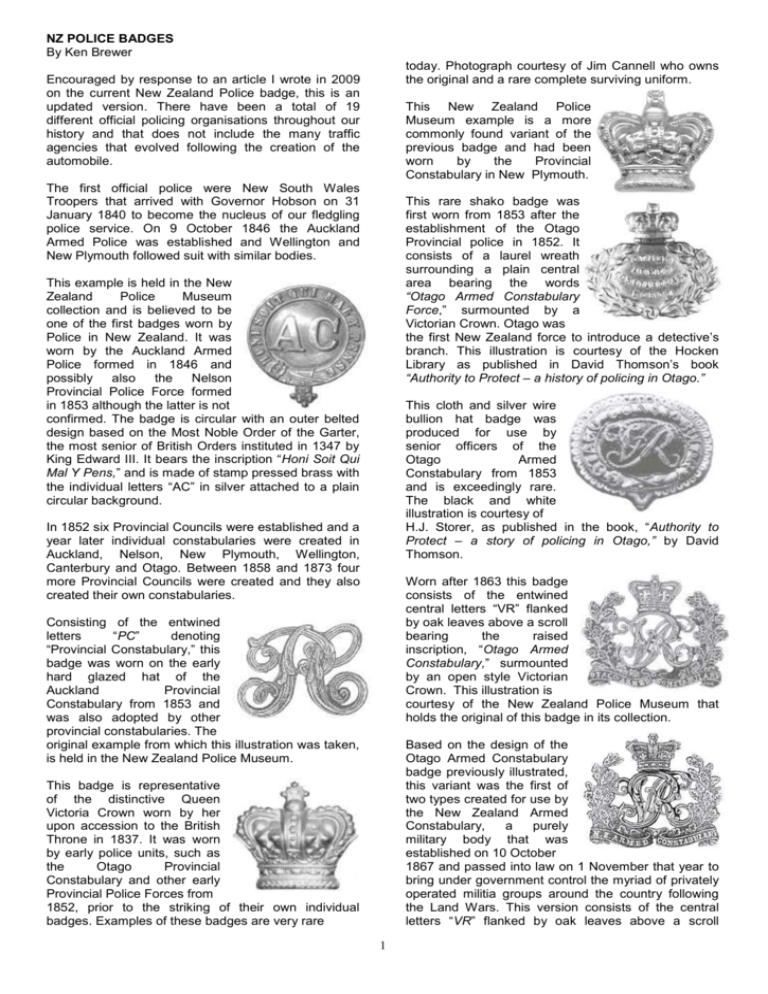NZ_Police_Badges
advertisement

NZ POLICE BADGES By Ken Brewer today. Photograph courtesy of Jim Cannell who owns the original and a rare complete surviving uniform. Encouraged by response to an article I wrote in 2009 on the current New Zealand Police badge, this is an updated version. There have been a total of 19 different official policing organisations throughout our history and that does not include the many traffic agencies that evolved following the creation of the automobile. This New Zealand Police Museum example is a more commonly found variant of the previous badge and had been worn by the Provincial Constabulary in New Plymouth. The first official police were New South Wales Troopers that arrived with Governor Hobson on 31 January 1840 to become the nucleus of our fledgling police service. On 9 October 1846 the Auckland Armed Police was established and Wellington and New Plymouth followed suit with similar bodies. This rare shako badge was first worn from 1853 after the establishment of the Otago Provincial police in 1852. It consists of a laurel wreath surrounding a plain central area bearing the words “Otago Armed Constabulary Force,” surmounted by a Victorian Crown. Otago was the first New Zealand force to introduce a detective’s branch. This illustration is courtesy of the Hocken Library as published in David Thomson’s book “Authority to Protect – a history of policing in Otago.” This example is held in the New Zealand Police Museum collection and is believed to be one of the first badges worn by Police in New Zealand. It was worn by the Auckland Armed Police formed in 1846 and possibly also the Nelson Provincial Police Force formed in 1853 although the latter is not confirmed. The badge is circular with an outer belted design based on the Most Noble Order of the Garter, the most senior of British Orders instituted in 1347 by King Edward III. It bears the inscription “Honi Soit Qui Mal Y Pens,” and is made of stamp pressed brass with the individual letters “AC” in silver attached to a plain circular background. This cloth and silver wire bullion hat badge was produced for use by senior officers of the Otago Armed Constabulary from 1853 and is exceedingly rare. The black and white illustration is courtesy of H.J. Storer, as published in the book, “Authority to Protect – a story of policing in Otago,” by David Thomson. In 1852 six Provincial Councils were established and a year later individual constabularies were created in Auckland, Nelson, New Plymouth, Wellington, Canterbury and Otago. Between 1858 and 1873 four more Provincial Councils were created and they also created their own constabularies. Worn after 1863 this badge consists of the entwined central letters “VR” flanked by oak leaves above a scroll bearing the raised inscription, “Otago Armed Constabulary,” surmounted by an open style Victorian Crown. This illustration is courtesy of the New Zealand Police Museum that holds the original of this badge in its collection. Consisting of the entwined letters “PC” denoting “Provincial Constabulary,” this badge was worn on the early hard glazed hat of the Auckland Provincial Constabulary from 1853 and was also adopted by other provincial constabularies. The original example from which this illustration was taken, is held in the New Zealand Police Museum. Based on the design of the Otago Armed Constabulary badge previously illustrated, this variant was the first of two types created for use by the New Zealand Armed Constabulary, a purely military body that was established on 10 October 1867 and passed into law on 1 November that year to bring under government control the myriad of privately operated militia groups around the country following the Land Wars. This version consists of the central letters “VR” flanked by oak leaves above a scroll This badge is representative of the distinctive Queen Victoria Crown worn by her upon accession to the British Throne in 1837. It was worn by early police units, such as the Otago Provincial Constabulary and other early Provincial Police Forces from 1852, prior to the striking of their own individual badges. Examples of these badges are very rare 1 containing the raised inscription “N.Z. Armed Constabulary”. It is surmounted by a solid type Victorian Crown that bears exaggerated jeweled appendages to its upper and outer edges, which is unique to this badge. Constabulary buttons. This new sterling silver badge featured the Royal Coat of Arms flanked by oak leaves mounted above a scroll bearing the raised inscription “New Zealand Police” and was surmounted by an open style Victorian Crown. This is the second and more common variant worn by New Zealand Armed Constabulary from 1867 with the principal difference being the open style, standard shaped Victorian Crown that surmounts it. Some surviving examples of this badge are found minus the crown, this being due to the nature of the authority the badge bestowed upon the wearer and the respect it was shown. When the Constable retired he was often permitted to retain his badge as a keepsake, but in deference to the Queen the crown was removed. It was worn from 1867 until the formation of the New Zealand Police in September 1886, although use of this badge was carried over until a replacement was struck and issued in 1897. This badge, also in sterling silver, was introduced by Commissioner Dinnie in 1903 after the death of Queen Victoria and whilst the design is similar to its predecessor, the principal differences are the inclusion of the Imperial Crown and the increase in size of the central Royal Coat of Arms and the reduction in size of the oak leaves which flank it. A new uniform was also introduced at this time with new buttons. The design of the current New Zealand Police badge made its first appearance 95 years ago in 1913, when it was introduced in a darkened bronze form by Commissioner of Police John Cullen, the first man to have risen through the ranks to that position. In 1870 the Auckland Provincial Council was approaching bankruptcy and to save money they amalgamated their constabulary into the military New Zealand Armed Constabulary. In 1876 all Provincial Councils were abolished and their constabularies were also amalgamated into the Armed Constabulary. It was during this period that the term ‘Field Force’ appeared as a means of differentiating the military role from the policing role. However, when military style duties began to take precedent over from policing duties, public outcry led the government to create a new fully separate and single policing body for the whole country and this was named the New Zealand Constabulary Force. However it continued to wear the same Armed Constabulary badge throughout its existence and it continued to be an armed body. The badge was issued in two forms. The larger version shown here was domed in shape and worn on the traditional helmet. A smaller version flat in profile, was issued for use on the forage caps of all commissioned officers and later were also worn by senior sergeants when that rank was established in 1915. This design continued to be worn under three successive Police Commissioners until William Bernard McIlveney took over as Commissioner in 1926. The following year he replaced it with a sterling silver badge that consisted of the Royal Crest and became popularly known as the “Lion and Unicorn” badge. Superintendents wore it gold plated in a slightly smaller form. After this time the Armed Constabulary evolved its purely military role and began to adopt a new badge of its own, selecting the Glengarry badge. The design was based on the British Most Noble Order of the Garter, bearing the inscription “Armed Constabulary,” surrounding the letters “NZ” on a diagonal hequered central background. Flanked by oak leaves on each side, it is surmounted by a solid Victorian Crown. McIlveney however maintained the lineage by retaining the 1913 design for his own forage cap and this was also gold plated. He also wore a large Sam Brown belt bearing gold plated versions of the larger helmet badge and this uniform is displayed in the New Zealand Police Museum. Unfortunately such extravagance leading up to the depression years and an enquiry into a dismissal he had personally authorised, led to him being asked to resign in 1930. Following the creation of the New Zealand Police on 1 September 1886 a new badge was designed, but due to economic reasons it was not available for issue until 1897. In the interim the old NZ Armed Constabulary badge was retained, along with the uniform and Armed He was replaced by R.P. Ward the under secretary for Justice until the appointment that year of Ward George Wohlmann, who quickly withdrew the silver badge and reissued the original 1913 badges to all ranks. 2 This design was to remain largely unchanged for the foreseeable future with the exception of some small cosmetic alterations due to manufacturing changes and a new Crown. helmet was withdrawn in 1995. Meanwhile the smaller variant remained in use on the forage caps of commissioned officers. The introduction of a formal mess dress uniform for commissioned officers in 1961 also saw a small badge produced to be worn on each lapel. In subsequent years a nickel plated version replaced the original helmet and cap badges until the first of the chromium plate versions appeared in the late 1940s. The exact date the chromed version first appeared is not known, but it was the last variant to bear the old Tudor Crown that was universally known as the “Kings Crown.” This was also produced in a helmet and forage cap versions. In 1976 another uniform change occurred with the introduction of the vitric blue uniform for all ranks. At this time the previous forage cap badge was enhanced by the insertion of a red insert for all ranks. In 1953 the introduction of the first uniform for policewomen also saw a new cap badge specifically designed for their use. It bore the Tudor Crown above the words “NZ POLICE” in a curved form. Meanwhile, men continued to wear the existing badge. In 1995 the helmet was replaced with the Australian style Akubra wide brimmed hat and with it came a new one piece moulded cap badge with a red enamel infill. In line with this change, a new commissioned officers mess dress lapel badge was also issued. However, the death of King George VI in 1952 and the Accession to the Throne of Queen Elizabeth II required an official change to the Saint Edwards Crown, but financial constraints prevented the immediate replacement of the badges worn by the New Zealand Police. However, steps were already in place to update the men’s uniform to the open collar design, so a decision was made to start implementing the badge changes at that same time. That same year two designs were submitted for a completely new badge and two examples of one of them were made. The primary change saw the introduction of the words “New Zealand Police” on the badge, but it did not gain favour, possibly due to cost and its production was not proceeded with. OTHER NZ POLICE BADGES The new men’s uniform was introduced in 1956 and with it came a new forage cap badge for all lower ranks including NCOs. An ammunition pouch, or ‘Cartouche’ badge, worn by members of the New Zealand armed Constabulary in 1860s. The first helmet badge to bear the Saint Edwards Crown of Queen Elizabeth II was also issued in 1956. Painted black, it was in use until withdrawn in 1960 and is today quite a rare item. A copper lapel badge issued by the New Zealand Farmers Union to those who volunteered their services to be ‘Special Constables’ during the national 1913 watersider’s strikes. A replica of the 1927 issue badge was introduced for use by the highland pipe bands that began to appear following WWII, with Auckland’s being established in 1948. It was worn with a red cloth backing. Photo courtesy of Barry Wallace. That year it was replaced by the familiar chromium plated version and that remained in use on helmets and officers caps untouched until 1976 when the cap badge was modified. The larger helmet models ceased to be worn when the 3 A forage cap sized badge fitted with a vertical rear brooch pin attachment for use on the kilts of Police highland Pipe bands. Photo Courtesy of Derek Cantello. An official NZ Police brass lapel badge intended for issue for identification purposes for ‘Police Special Constable’ volunteers, but never issued. Arm bands were issued instead. A 1980s lapel badge worn for identification purposes by members of the VIP Squads, the forerunners of the modern Diplomatic Protection Squads. A New Zealand Police Diplomatic Protection Squad lapel identification badge of the 1990s. A pair of lapel badges issued from 20 February 1993 to serving police members who were successful in lifting multiple fingers prints from the scenes of crime that led to conviction. There was no distinction between the colours. AFIS stood for Automated Fingerprint Identification System and marked the introduction of that computer based system. A 1986 lapel badge made in limited numbers and issued to members of the New Zealand Police Maori Culture Group, TeReo Pirihimana – “The voice of the Policeman.” A lapel pin introduced by the New Zealand Police Association in 2008 depicting the Huia father to be worn at police funerals and in the week leading up to Saint Michael’s day the patron Saint of Policemen on 29 September each year. This date commemorates all police lost in the line of duty. Photograph courtesy of the New Zealand Police Association. NOTE: All illustrations from the author’s collection unless stated otherwise. 4




